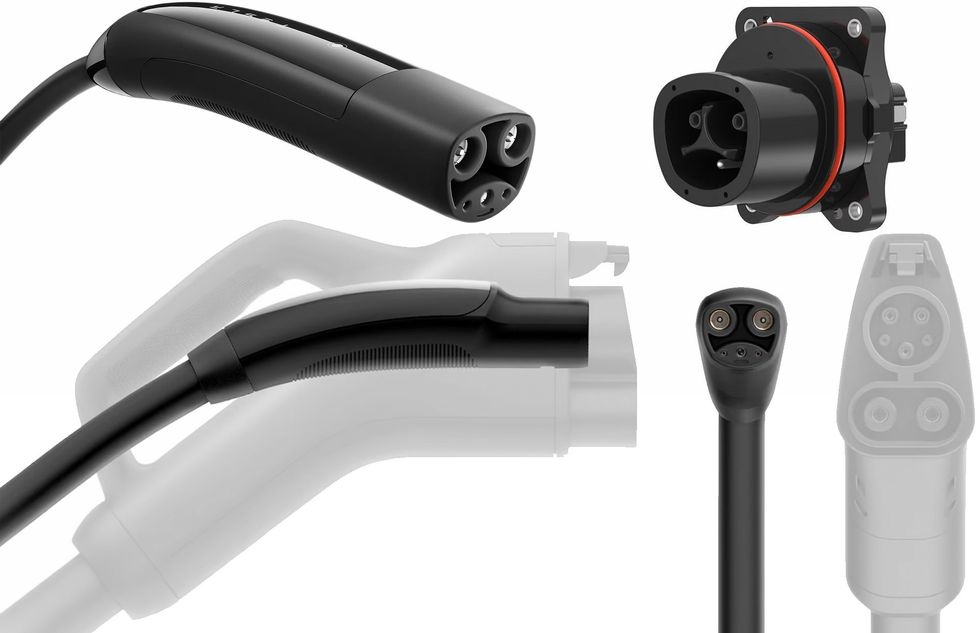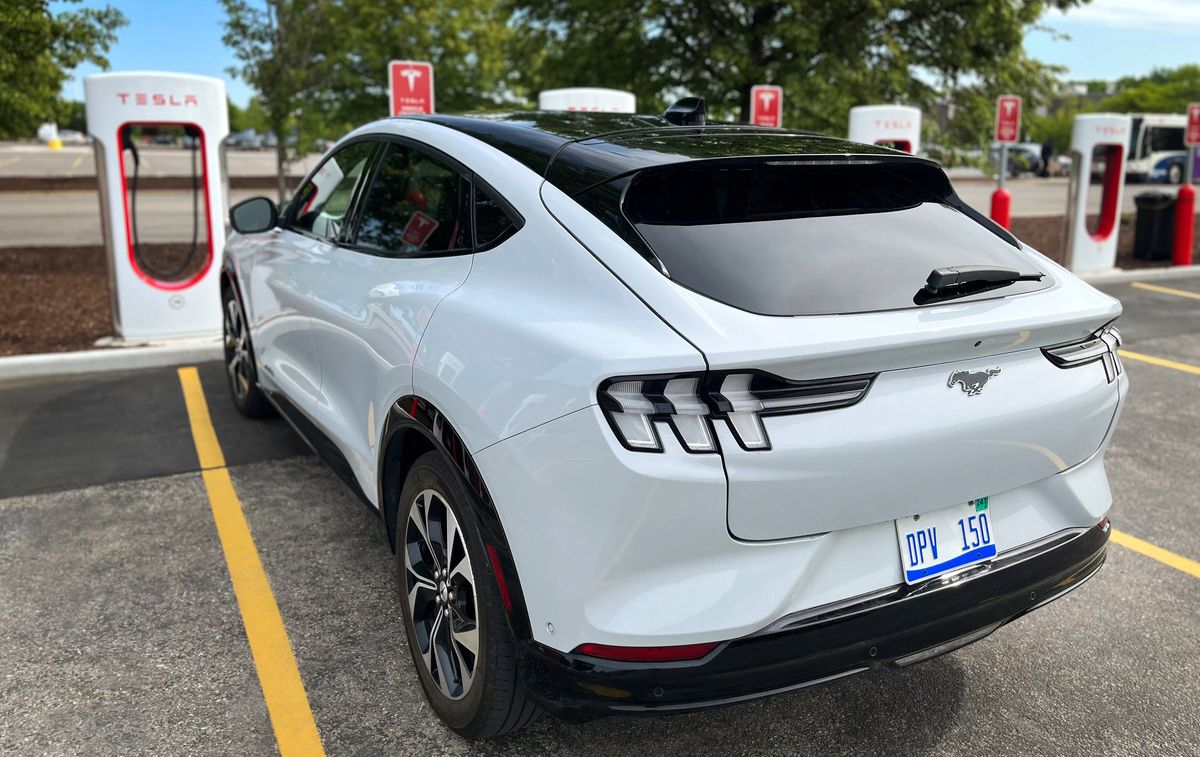Tesla forced slumbering automakers to get into the electric game. Now, in an ultimate twist on “If you can’t beat ’em, join ’em,” Tesla is backing them into joining its dominant public charging network in America.
In a stunning repudiation of the Combined Charging System (CCS) network—whose scattershot reliability has rankled EV owners or left prospects leery about buying one—a Who’s Who of automakers will unplug from CCS in favor of Tesla’s trustworthy North American Charging Standard (NACS).
Ford and Tesla said in May they would partner to let Ford EV customers access up to 12,000 Tesla Superchargers and slower Destination Chargers in the United States and Canada by the end of 2024, via a “Magic Dock” adapter that’s already being integrated at a handful of Tesla stations. The dominoes haven’t stopped falling. General Motors was next, quickly joined by Volvo, Polestar, Rivian, Mercedes, and Nissan. Those automakers will ditch CCS entirely on new EV models beginning in 2025, in favor of Tesla’s less-fragile, more-reliable NACS connector. (Although, as noted below, GM and Mercedes also announced last month that they’ve teamed up with BMW, Hyundai, Kia, and Stellantis to develop a charger network that would include CCS charging.)
Elon Musk must now reassure or appease Tesla owners who may not want to share precious Superchargers with Chevys, Hyundais, and other newcomers.
In response, the Society of Automotive Engineers, despite having thrown its weight behind CCS, announced it will standardize Tesla’s formerly proprietary connector, ensuring that “any supplier or manufacturer will be able to use, manufacture, or deploy” the open-source system across North America. ChargePoint and the Volkswagen-owned Electrify America (EA) in June announced they would add NACS stations to their existing CCS networks. EA said it would begin offering NACS connections in 2025.
In November, Tesla threw down the gauntlet by rebranding its pioneering Supercharger plug as “NACS” and releasing its specs and designs for public use. Elon Musk had long pledged to open his far-flung network—now arguably Tesla’s biggest advantage over rivals that have closed the gap in EV performance and range—but the Biden administration clearly gave Musk a monetary nudge. To be eligible for a share of up to US $7.5 billion in federal funds earmarked for public charging, Tesla must open its system to all comers. The administration’s National Electric Vehicle Infrastructure (NEVI) program aims to build chargers along 7,500 miles of the nation’s busiest highways, toward an ambitious goal of 500,000 total public chargers by 2030.

In their November NACS announcement, Tesla said its NACS vehicles outnumber CCS cars by two-to-one in the United States. The dominant EV automaker boasts a network of nearly 18,000 Superchargers, at nearly 1,800 locations. It offers, in other words, 60 percent more DC charging posts than all CCS networks combined. Compared with the CCS connector, whose internal clip has proven vulnerable to breakage and failure in the field, Tesla’s Supercharger plug has no moving parts and is roughly half the size, making it less cumbersome to use.
CCS charging was wonky to begin with
Tesla has the quantity covered, and “quality is unequivocally where Tesla has an edge,” said E.J. Klock-McCook, principal of the carbon-free transportation team at the Rocky Mountain Institute. Tesla, he said, claims an uptime rate of 99.95 percent on its network. That is well beyond the 97-percent minimum that is a requirement for charging companies seeking funding under NEVI. And it stands in painful contrast to other charging outfits. According to a recent J.D. Power report, nearly 21 percent of EV drivers surveyed experienced charging failures at CCS stations in the first quarter of 2023 that left them unable to access juice.
“Public charging is by far the least satisfying aspect of owning an electric vehicle,” said Brent Gruber, executive director of global automotive for J.D. Power. “Not only is the availability of charging still an obstacle, but EV owners continue to be faced with charging station equipment that is inoperable.”
“These new standards are going to be very important, to ensure compatibility across platforms, cars, and automakers.”
—E.J. Klock-McCook, Rocky Mountain Institute
Recent studies, including from J.D. Power, shows that charging concerns are preventing some car shoppers from buying EVs. My own experience charging dozens of EVs has seen too many broken or underperforming CCS chargers to count. Anecdotally, at least one Electrify America stall seems to be out of order at every multiplug EA charging station. For CCS users, desperate phone calls to charging company phone reps are an all-too-familiar hassle—including in desolate or nighttime locales—as reps try their best to reboot wonky chargers or figure out why they’re delivering a trickle of the advertised juice.
Experts said the Wild West of charging appears due for more unpredictable shootouts. Elon Musk must now reassure or appease Tesla owners who may not want to share precious Superchargers with Chevys, Hyundais, and other newcomers. Executives of Ford and other companies insist their customers will not be second-class citizens at Tesla stations.
Experts note Tesla had it easier until now. The California automaker’s chargers had to work with and communicate only with its own limited lineup of models. The company’s enviable vertical integration saw cars, software, and chargers designed and built in-house. A proprietary phone app and automated back-end payments have made charging a Tesla a seamless plug-and-play experience. In contrast, users of the balkanized CCS network, with myriad competing operators, have been forced to fumble with credit cards—another notorious pain point when card readers become inoperable—and set up separate payment accounts and mobile apps for each operator. Executives of CCS charging companies have complained that automakers sometimes make vehicle software changes without informing them, leading to connection failures that end up unfairly blamed on charging companies. Now, Musk must accept the responsibility to work closely with other automakers and their myriad brands, including sharing specs and software to ensure smooth interoperability.
“These new standards are going to be very important, to ensure compatibility across platforms, cars, and automakers,” Klock-McCook said, adding that CCS-equipped cars will still be sold for years and will need reliable refueling for decades to come. “The race is on now to get those integrations ready when access opens up. And only time will tell how that goes.”
Experts wonder if Musk will play nicely with others as they ride Tesla’s charging coattails, and for how long.
For this nascent shared network, a handful of Tesla Magic Dock stations are already revealing compatibility and logistical issues. One is distressingly sluggish when charging EVs designed to take advantage of faster 800-volt charging, versus Teslas and other models with 400-volt onboard systems. That’s what happened when I charged a colleague’s Kia EV6 at a Tesla Magic Dock stall in Brewster, N.Y. The Kia slurped juice at less than a 50-kilowatt rate on the Supercharger. That’s less than a quarter of the 200-plus kW the Kia absorbs on the mightiest, 350-kW CCS chargers, which allow a 10- to 80-percent charge in about 18 minutes. Owners have experienced similar issues with every 800-V model from Kia, Hyundai, Genesis, the Porsche Taycan, and Lucid Air.
The current CCS standard can deliver 350 amperes at up to 1,000 V and a maximum 350-kW charging rate. CCS hardware of up to 700 kW has been demonstrated. Tesla’s current V3 Superchargers are rated at 480 V and still deliver up to a maximum 250 kW, but only for Teslas or other models with an onboard 400-V electrical system. (Tesla is testing V4 units that will allow the new Cybertruck to access 1,000-V capability and a maximum rate of 615 kW, far beyond what cars themselves are currently designed to accept.)
Interlopers at Tesla’s Magic Dock stations are also being stymied by something more mundane: cords that aren’t long enough to easily reach models with charge ports in nonstandard locations. A Consumer Reports tester had to park a Lucid Air sideways across three Supercharger stalls to reach a port located on a front fender, versus the rear taillight assembly of most Teslas. Fortunately, no Tesla owners showed up for an infuriating glimpse of these early days of share-and-share-alike. Given inevitable customer carping and Musk’s mercurial and competitive nature, experts wonder if Musk will play nicely with others as they ride his charging coattails, and for how long.
Several automakers aren’t willing to let CCS die without a fight. In late July, GM, BMW, Mercedes, Hyundai, Kia, and Stellantis announced a plan to install at least 30,000 high-powered charge points “in urban and highway locations to ensure customers can charge whenever and wherever they need.” Those refueling points will integrate both CCS and Tesla plugs. The move seeks to double the number of EV fast chargers in the United States, to more than 60,000.
Karl Brauer, an industry analyst and executive editor of iSeeCars, said Ford, GM, and other Tesla rivals have realized that developing new models alone won’t convert the masses from internal-combustion cars. His company data shows consumer demand stalling and EVs piling up on dealer lots.
“Rather than putting all their future R&D eggs in the product basket, automakers need to jointly solve the infrastructure problem,” Brauer said. He pointed to the National Renewable Energy Laboratory, which projects a need for more than 180,000 fast chargers by 2030.
“So even with this massive collaboration across seven global automakers,” he says, “we’ll still only be a third of the way there.”
- Solving the Electric Vehicle Charging Conundrum - IEEE Spectrum ›
- What You Need to Know About Charging Before You Buy an EV ... ›
- There’s a Queue Coming for Tesla Charging, and That’s OK ›
Lawrence Ulrich is an award-winning auto writer and former chief auto critic at The New York Times and The Detroit Free Press.



